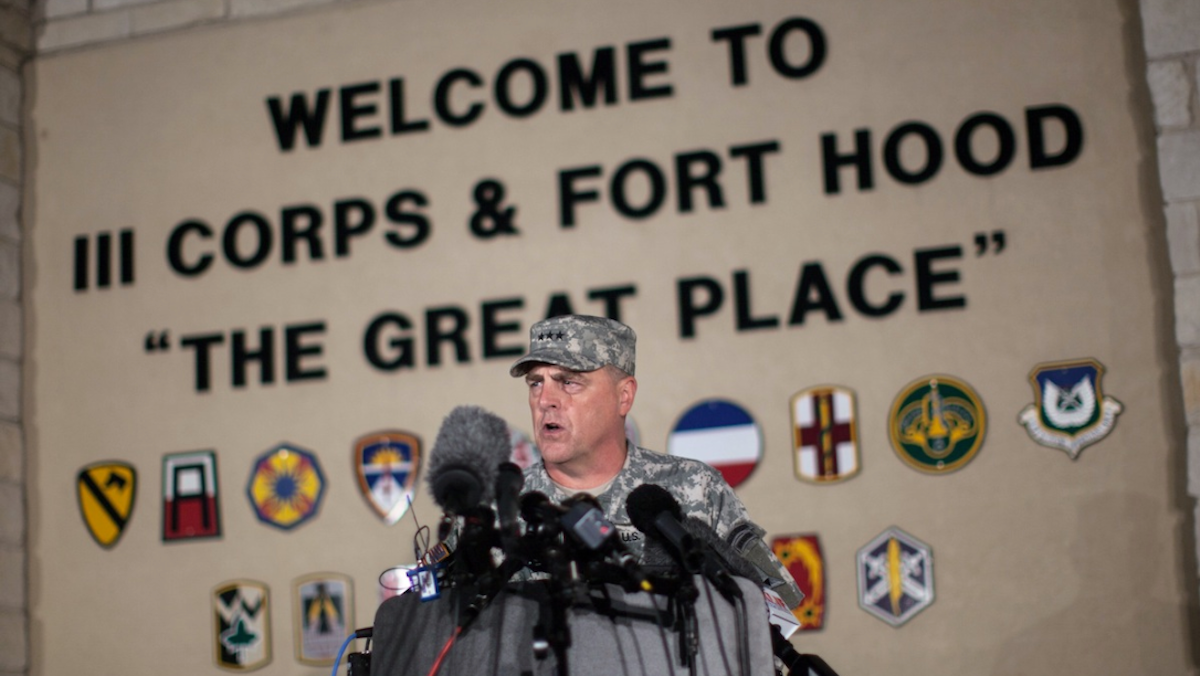Not every veteran is the Fort Hood shooter

Lt. Gen. Mark Milley, commanding general of III Corps and Fort Hood, speaks with the media outside of an entrance to the Fort Hood military base following a shooting that occurred inside, Wednesday, April 2, 2014, in Fort Hood, Texas. Four people were killed, including the gunman, and 16 were wounded in the attack, authorities said. (AP Photo/Tamir Kalifa)
Wednesday, around 4 p.m. A tranquil Texas afternoon was shattered by the sound of a .45-caliber semi-automatic handgun. In the chaos that followed, three lives were taken, 16 other victims were injured.
And that was just the beginning.
Fort Hood, the sprawling Army facility in Texas where the shootings took place, went into lockdown mode. By all accounts, communication both inside and outside the base was efficient, because the facility had experienced tragedy before.
The trajectory
But in a horrifying display of déjà vu, the shooter was efficient, as well.
He traveled by car from one building to another, firing as he went. When, finally, a female military police officer confronted him in a parking lot, the gunman shot himself, bringing the death toll from his shooting spree to four.
It took hours for military and civilian investigators to determine that the base was safe.
It will take longer for the rest of us to fully engage with the soldiers coming home from our wars.
Deeper than what happened Wednesday
Fort Hood, it seems, is emblematic of the problems that arise when a nation’s military is engaged in warfare, both on and off the battlefield.
In 2009, Maj. Nidal Malik Hasan, an army psychiatrist who was about to be deployed to Iraq, killed 13 and wounded 32 in a shooting. In court, he said he shot his fellow soldiers to protect Taliban leaders in Afghanistan from the American military. He had not yet been to war when he did it, but in his mind, he was fighting against the very people with whom he served.
Wednesday’s shooter had not been publicly identified at press time because the military was seeking to notify his family. (Update: He has since been identified as Specialist Ivan Lopez.)
A motive had not yet been established, either. But we know, from the statements made by Lt. General Mark Milley during a press conference, that the gunman was a soldier. And, he was fighting demons even before he went off base to purchase the .45 he used to sow terror at Fort Hood.
The gunman’s history
The gunman served four months of in Iraq in 2011, and transferred to Fort Hood from another installation this February.
Prior to the shooting spree that led to his death, he was undergoing behavioral-health and psychiatric treatment for depression and anxiety, Milley said. The gunman was also in the midst of a long diagnostic process to determine if he was suffering from Post Traumatic Stress Disorder.
This was a man who was apparently fighting a mental battle every day. He was on medication, and though he’d said he suffered a traumatic brain injury in Iraq, Milley said there was no record that the gunman ever suffered such an injury.
What they carry
But sometimes the injuries our soldiers suffer are the kind we can’t see.
They are the memories of a roadside bomb exploding just a few feet away.
They are the recollections of cold dead eyes staring up from a dusty road.
They are the feelings of guilt over the death of a fellow soldier.
They are the tattered emotional bags that are carried home from war.
This is not to say every veteran is a ticking time bomb. They aren’t. But veterans who return from the wars in Iraq and Afghanistan face unique barriers, including high unemployment rates, traumatic injuries and emotional distress. This can make adjusting to civilian life difficult.
What they face at home
As of November of last year, the unemployment rate among veterans who’d served since 9/11 was about 10 percent, according to the Washington Post. Some policymakers trace their difficulties to high disability rates, lack of civilian work experience and onerous state licensing regulations around certain jobs.
But there is an elephant in the room, as well. Its name is prejudice.
Many of us believe see an incident like Wednesday’s shooting and believe that all veterans are that veterans are on the cusp of committing such an act.
We see a veteran with a disability and we recoil, because it makes us uncomfortable.
We see the sacrifice they’ve made and we feel guilty because we haven’t done the same.
We need to help them
As much as we say we support the troops, our returning soldiers still suffer. Even as I write this, there are homeless veterans huddled along Philadelphia’s Logan Circle. The rest of us have the power to change that.
Even as we watch the aftermath of the horrific shooting at Fort Hood, and sift through the statements of condolence from President Obama and others, we must not lose sight of this fact.
The shooter does not represent all veterans. They are not cardboard cutouts or movie caricatures. They are people.
If we are to leave behind the wars that have taken so much from our soldiers, we have to take care of them or, at the very least, we have to give them the means to take care of themselves.
Our veterans have to know we’re there for them. Not with a hand out, but with a hand up. Otherwise, our wars will come home.
WHYY is your source for fact-based, in-depth journalism and information. As a nonprofit organization, we rely on financial support from readers like you. Please give today.

